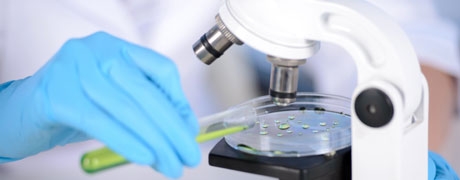Columns
Cutting-Edge Science of Botanical Identification
AHPA’s Botanical Congress explores the latest methods and techniques for herbal analysis.
By: Maged Sharaf

The herbal products industry employs a host of methods and technology to identify botanical ingredients accurately and efficiently, from traditional methods like macroscopic and organoleptic analysis to cutting-edge techniques like nuclear magnetic resonance (NMR) and DNA analysis.
AHPA holds its Botanical Congress every year in conjunction with SupplySide West, where experts discuss a host of issues that impact the herbal industry. The fourth Congress, held in October, explored the science and technology of herbal identification.
AHPA Botanical Identity References Compendium
The Congress also provided an overview of AHPA’s Botanical Identity References Compendium, a free, online resource that facilitates the sharing of knowledge and resources relevant to accurate identification of herbal materials. Merle Zimmermann, AHPA’s chief information officer, demonstrated how the compendium provides a cooperative and centralized source of information on physical and chemical methods that can be used by qualified analysts to determine the identity of herbal articles. Mr. Zimmermann encouraged attendees to share identity materials to help increase the breadth and depth of this resource.
Voucher Specimen
Steven Yeager, the laboratory/quality control manager at Mountain Rose Herbs, demonstrated the importance of a voucher specimen as a botanical reference material that has been identified by a trained botanist and is preserved for future reference or analysis. He listed the information to accompany a voucher specimen and details of its preparation.
Macroscopy, Organolpesis & Microscopy
Elan Sudberg, the CEO of Alkemist Labs, provided an overview of macroscopic, organoleptic and microscopic analysis of herbals.
Assessing the identity of crude herbs in as whole a form as possible is one of the most definitive ways to assure identity and is the most rapid and cost-effective analytical technique for doing so, according to Mr. Sudberg. It is the only technique where identity, quality (based on organoleptic characteristics), and the presence of adulterants, foreign organic matters, etc. can be discerned in a single test. Macroscopy, microscopy and organolepsy are direct assessments of the plant material while many other techniques assess the chemical characteristics and profiles of plant materials. Macroscopic and organoleptic characterization are the most rapid, inexpensive and environmentally clean analytical techniques, Mr. Sudberg said.
These techniques also have drawbacks, though. Mr. Sudberg noted that in some cases of closely related articles, macroscopic and organoleptic analysis characterization must be coupled with other techniques.
Highlighting the benefits of microscopy, Mr. Sudberg said this method can detect excipients, filler and detritus commonly missed by more technologically advanced techniques. It generates nearly no waste and requires a small amount of preparation. However, microscopy is only suitable for raw materials. While it can be effective even for the finest powders, it is not suitable for extracts.
High Performance Thin-Layer Chromatography (HPTLC)
Fabien Scorza, national sales and marketing manager, CAMAG, demonstrated how HPTLC can provide chemical fingerprints for botanical material and can be used to analyze multiple samples simultaneously that can be compared for similarities and differences even without knowing the nature of the chemical constituents. He said that results are easily reproduced on different plates and in different labs. This technique utilizes the human eye to detect similarities and differences and documentation is simple.
Mr. Scorza noted that HPTLC can complement other techniques like HPLC in terms of separation power.
High Performance Liquid Chromatography (HPLC)
Darryl Sullivan, director of scientific affairs at Covance Laboratories, shared several benefits of HPLC for herbal identification. He noted that most testing labs have HPLC systems and that the cost of the instruments is reasonable. HPLC also offers a great deal of flexibility. It can be used for other types of testing in the lab and can provide identification and quantification of constituents in a single analysis. Mr. Sullivan noted that HPLC can provide significant specificity, is reproducible, can be automated for use 24 hours a day/seven days a week, and requires the analyst to only have a moderate amount of experience compared to some other methods.
Mr. Sullivan highlighted that HPLC methods can be “fooled” with spiking compounds and that interpretation of HPLC chromatograms can be a challenge for inexperienced analysts. He noted that HPLC shouldn’t be used as a stand-alone tool, but should be combined with other identification methods.
Fourier Transform Near Infrared (FT-NIR)
FT-NIR captures an overall picture (spectral fingerprint) of the plant material, according to Frank Jaksch, president and CEO of Chromadex. Unlike other methods that rely on an analyst opinion and/or visual interpretation, FT-NIR utilizes a specialized software approach that references hierarchical authenticated libraries to verify identity through data calculation and numerical pass/fail criteria. Mr. Jaksch listed several benefits of FT-NIR, including the fact that it can be used to simultaneously detect adulterants, is cost-effective, and can help companies meet FDA cGMP requirements.
Mr. Jaksch said Chromadex is working on ways to use this technology to analyze blended samples, pre-mixes and finished products, and to perform quantitative analysis. Chromadex is also working to use FT-NIR technology to detect differences in various extract concentrations.
DNA
Damon Little, the associate curator of bioinformatics in The Lewis B. and Dorothy Cullman Program for Molecular Systematics, provided an overview of DNA analysis for botanical identity. He noted that this approach provides a highly sensitive analysis and unambiguous data interpretation that allows even non–specialists to identify specimens. In addition, this technique is highly reproducible, variable enough to distinguish between closely related species, and is useful to identify morphologically deficient or incomplete (e.g., powders) specimens.
Some limitations outlined by Mr. Little include the fact that not all samples contain DNA of sufficient quality to be analyzed and markers have not been identified (or validated) for many common herbs.
Nuclear Magnetic Resonance (NMR)
Jimmy Yuk, a research scientist at Bruker BioSpin, explained why NMR is a powerful tool for competitive analysis due to its strength in evaluating complex mixtures. Mr. Yuk noted that NMR methods are highly reproducible from site to site and have low analytical variance compared to other analytical techniques. It also requires few preparation steps and no need for derivatization. NMR can create unique chemical fingerprints to distinguish species and origin, impurities and potential adulterants. There is also no need to run standards daily and an NMR spectral database of a material can be shared with any NMR lab to identify and quantify compounds in herbal mixtures.
Flash Chromatography
Jahan Marcu, the director of research and development at Green Standard Diagnostics, and Melissa Wilcox, the technology manager at Grace Discovery Sciences, provided an overview of the benefits of flash chromatography. This method removes compounds from interfering matrix components, isolates and collects material for additional testing, and reduces sample preparation time and costly instrument downtime. Mr. Marcu demonstrated how flash chromatography can be used to isolate cannabinoids from complex matrices.
Maged Sharaf, PhD, is the chief science officer of the American Herbal Products Association (AHPA), the national trade association with a focus primarily on herbs and herbal products. AHPA’s membership represents U.S. and international growers, processors, manufacturers, marketers and institutes specializing in botanicals and herbal products. Before AHPA, Dr. Sharaf was the director, Foods, Dietary Supplements and Herbal Medicines at the United States Pharmacopeial Convention (USP). Before USP he was pharmacy associate professor and has preceding experience conducting bioanalytical assay development and validation, and human bioequivalence studies in support of the pharmaceutical industry; and quality control and manufacturing of pharmaceutical dosage forms. He can be reached at 301-588-1171; E-mail: msharaf@ahpa.org; Website: www.ahpa.org.




















